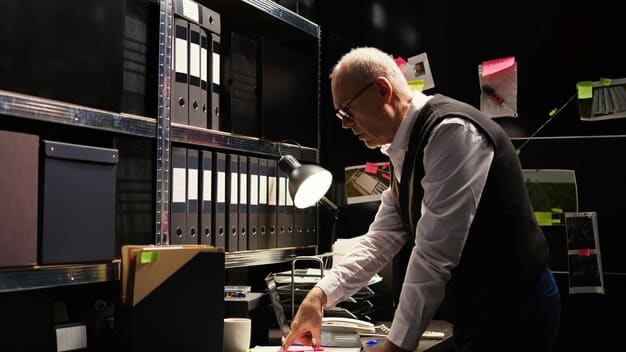Cult Documentary Preservation: Why It Matters & How to Help

Cult documentary preservation encompasses efforts to save unique films that resonate with niche audiences, ensuring their survival for future generations through restoration, archiving, and promotion, thus preserving cultural value and cinematic history.
Cult documentary preservation: why saving these films matters and how you can help is crucial for maintaining our cultural heritage. These are films that, while not mainstream, hold significant artistic, historical, and social value. But why exactly should we care, and how can we contribute to their preservation?
Why Cult Documentaries Need Preservation
Cult documentaries, though not always commercially successful, often capture unique perspectives, subcultures, and historical moments that mainstream media might overlook. Preserving them ensures a diverse cinematic landscape for future viewers and researchers.
Consider the numerous independent documentaries that have explored niche topics, from underground music scenes to forgotten historical events. These films provide invaluable insights into corners of society and history that would otherwise be lost.
Historical and Cultural Significance
Cult documentaries often serve as time capsules, preserving cultural phenomena, counter-narratives, and social movements that might not be documented elsewhere. Their preservation safeguards diverse voices and histories.
Artistic and Educational Value
Many cult documentaries push the boundaries of filmmaking, experimenting with narrative structures and visual styles. Preserving these films ensures their survival as important works of art that can inspire future filmmakers and educate audiences about unconventional storytelling.
- Preserving Unique Perspectives: Cult documentaries often provide alternative viewpoints on historical events or social issues.
- Protecting Cultural Heritage: These films capture subcultures, traditions, and social movements that might otherwise be forgotten.
- Ensuring Access for Future Generations: Preservation allows future viewers and researchers to engage with these important cultural artifacts.
- Enhancing Cinematic Diversity: By saving cult documentaries, we contribute to a richer and more diverse film landscape.
Preserving cult documentaries ensures that these unique stories and artistic expressions are not lost to time. It’s about recognizing the value of diverse perspectives and safeguarding cultural heritage.

The Threat to Cult Documentaries
Cult documentaries face numerous threats that can lead to their loss or deterioration. These threats range from physical decay to obsolescence of film formats. Understanding these challenges is essential to implement effective preservation strategies.
Physical decay is a natural process that affects all film, but it is accelerated by poor storage conditions and neglect. Additionally, the rapid evolution of technology can render older film formats obsolete, making them difficult to access and preserve.
Physical Decay of Film
Film is a fragile medium prone to deterioration, especially if not stored properly. Factors such as humidity, temperature fluctuations, and exposure to light can accelerate the decay process. Nitrate film, used in early filmmaking, is particularly susceptible to decomposition and can even be a fire hazard.
Obsolescence of Formats
As technology advances, older film formats become obsolete, and the equipment needed to play them becomes increasingly scarce. This technological obsolescence poses a significant challenge to accessing and preserving these films. Transferring these films to digital formats is often the only way to ensure their survival.
- Deterioration of Film Stock: Over time, film can decompose, leading to irreversible damage.
- Color Fading: Color films are particularly vulnerable to fading, losing their original hues.
- Lack of Proper Storage: Inadequate storage conditions accelerate the decay process.
- Technological Obsolescence: Older film formats become unplayable as equipment becomes unavailable.
Recognizing these threats is the first step in addressing the urgent need for cult documentary preservation. Without intervention, many of these films could be lost forever.
Digitization: A Key Preservation Method
Digitization is a crucial method for preserving cult documentaries, allowing fragile film to be converted into a digital format. This process not only safeguards the content but also makes it more accessible to a wider audience.
By converting physical film into digital files, archivists can create multiple copies, ensuring that the documentary survives even if the original is lost or damaged. Digital formats also allow for easier distribution and viewing.
The Process of Digitization
Digitization involves scanning film frame by frame and converting it into a digital format, such as MP4 or MOV. This requires specialized equipment and expertise to ensure that the resulting digital file accurately represents the original film. The process may also include color correction and restoration to improve the image quality.
Benefits of Digital Preservation
Digital preservation offers numerous advantages, including enhanced accessibility, ease of duplication, and reduced risk of physical damage. Digital files can be stored in multiple locations and accessed from anywhere in the world, making them less vulnerable to loss.
- Increased Accessibility: Digital files can be easily shared and viewed online.
- Reduced Risk of Loss: Digital copies can be stored in multiple locations.
- Enhanced Image Quality: Digitization allows for color correction and restoration.
- Wider Distribution: Digital formats can reach a broader audience.
Digitization is a vital tool for preventing the loss of cult documentaries. It ensures that these films can continue to be viewed and appreciated by future generations.

The Role of Archives and Institutions
Archives and film institutions play a crucial role in preserving cult documentaries. These organizations often have the resources and expertise needed to properly store, restore, and digitize films. Their efforts are essential in safeguarding cinematic heritage.
Many film archives actively seek out and acquire cult documentaries, recognizing their historical and cultural value. These institutions provide the facilities and expertise necessary to ensure that these films are preserved for the long term.
National Film Preservation Foundation
The National Film Preservation Foundation (NFPF) is an independent non-profit organization created by the U.S. Congress to help save America’s film heritage. The NFPF provides grants to archives and institutions to support film preservation projects.
Library of Congress
The Library of Congress has a significant role in film preservation, including the National Film Registry, which selects films each year for preservation based on their cultural, historical, or aesthetic significance. This registry helps raise awareness about the importance of film preservation.
- Providing Storage Facilities: Archives offer climate-controlled vaults to prevent film decay.
- Securing Funding: Institutions seek grants to support preservation projects.
- Restoring Damaged Film: Archivists use specialized techniques to repair and restore deteriorated film.
- Promoting Awareness: Archives educate the public about the importance of film preservation.
The work of archives and film institutions is vital for ensuring that cult documentaries are properly preserved and made accessible to the public. Their efforts help maintain a rich and diverse cinematic landscape.
How You Can Help Preserve Cult Documentaries
Individuals can play a significant role in preserving cult documentaries. From supporting preservation initiatives to spreading awareness, there are many ways to contribute to this important cause.
One of the most effective ways to help is by supporting organizations that are actively involved in film preservation. You can also help by sharing information about the importance of preserving cult documentaries with friends and family.
Donate to Preservation Organizations
Financial contributions to organizations like the National Film Preservation Foundation (NFPF) and the Academy of Motion Picture Arts and Sciences can directly support film preservation projects. Even small donations can make a big difference.
Spread Awareness
Use social media to share information about the importance of preserving cult documentaries. Talk to your friends and family about why these films matter and encourage them to support preservation efforts. The more people who are aware of the issue, the greater the chance of success.
- Volunteer at Film Archives: Offer your time to help with preservation projects.
- Attend Screenings: Support screenings of restored cult documentaries.
- Share Information Online: Use social media to raise awareness about film preservation.
- Advocate for Funding: Contact your representatives to support funding for film preservation initiatives.
By getting involved, you can help ensure that these unique and valuable films are preserved for future generations. Every effort, no matter how small, contributes to the cause.
The Future of Cult Documentary Preservation
The future of cult documentary preservation depends on continued innovation, collaboration, and community engagement. By embracing new technologies and working together, we can ensure that these films continue to thrive.
Looking ahead, advancements in digital technology will likely play an even greater role in film preservation. Additionally, increased collaboration between archives, institutions, and individuals will be essential for success.
Technological Advancements
Advances in digital technology will continue to improve the efficiency and effectiveness of film preservation. This includes tools for automated restoration, more accurate color correction, and improved methods for long-term digital storage.
Community Engagement
Engaging with communities and audiences is crucial for building support for film preservation. By showcasing restored films and educating the public about the importance of preservation, we can create a greater appreciation for these cultural artifacts.
- AI-Driven Restoration: Artificial intelligence can automate many aspects of the restoration process.
- Cloud Storage: Cloud-based solutions offer secure and accessible long-term storage for digital files.
- Crowdfunding: Online platforms can help raise funds for preservation projects.
- Educational Initiatives: Schools and universities can incorporate film preservation into their curricula.
The future of cult documentary preservation is bright, provided we continue to embrace innovation, foster collaboration, and engage with communities. Together, we can ensure that these films continue to inspire and educate for generations to come.
| Key Point | Brief Description |
|---|---|
| 🎬 Importance of Preservation | Cult documentaries offer unique perspectives and cultural insights. |
| 🚨 Threats to Films | Physical decay and format obsolescence endanger these films. |
| 💾 Digitization | Digitization is a key method to safeguard and enhance accessibility. |
| 🤝 How to Help | Donate, spread awareness, and support film archives. |
FAQ
▼
Cult documentaries are films that, while not widely popular, have a dedicated following and often explore niche topics or unconventional styles. They provide unique perspectives and cultural insights.
▼
Preserving cult documentaries ensures diverse voices and histories are not lost to time. They frequently capture subcultures, social movements, and alternative viewpoints not found in mainstream media.
▼
The primary threats include physical decay of the film stock due to improper storage, color fading, and the obsolescence of older film formats, making them unplayable.
▼
Digitization converts fragile film into digital formats, enhancing accessibility and reducing the risk of loss. Digital copies can be easily shared, viewed, and stored in multiple locations.
▼
You can donate to film preservation organizations, volunteer at archives, spread awareness online, attend screenings of restored films, and advocate for funding for preservation initiatives.
Conclusion
Preserving cult documentaries is an essential endeavor that safeguards cultural heritage, ensures diverse historical perspectives, and enriches the cinematic landscape for future generations. By understanding the threats these films face and actively supporting preservation efforts, we can all play a role in ensuring their survival and continued appreciation.





